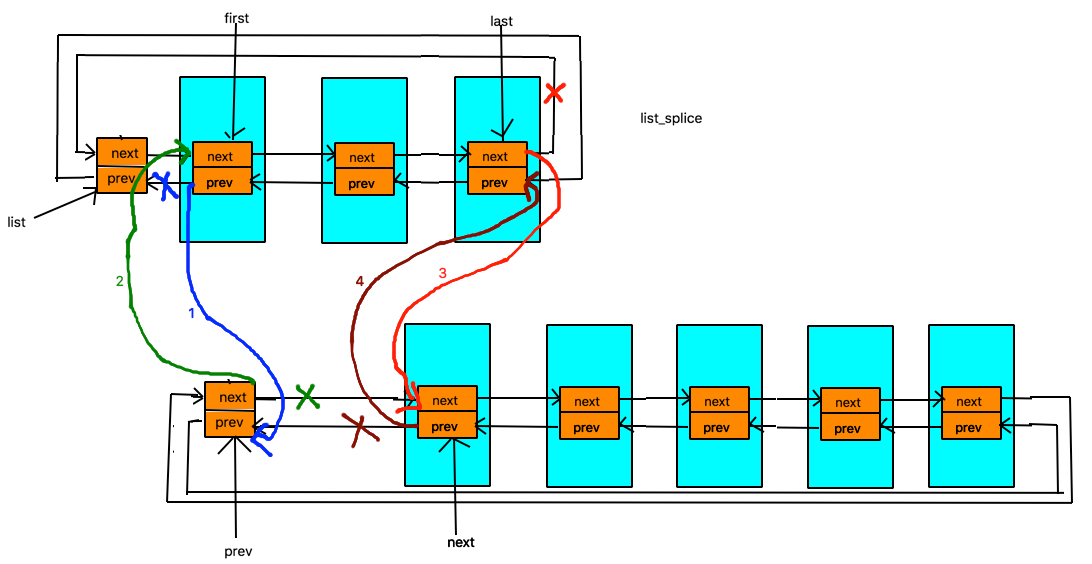内核基础设施——list_head结构解析
Contents
list_head用法经常在Linux kernel里面经常看见,该文对内核中的list_head进行了总结分析。
注意:本文的中的代码来自于内核版本
v4.16。
数据结构
在Linux内核中,list_head用来创建双向循环链表,kernel中对list_head的定义如下:
|
|
|
|
需要注意的一点是,头结点head是不使用的,这点需要注意。
使用list_head组织的链表的结构如下图所示:
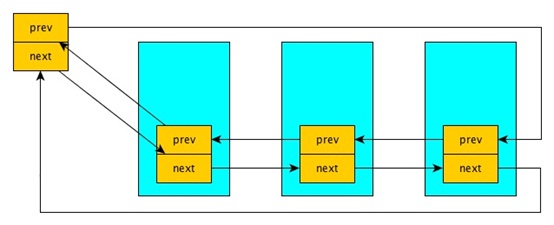
list_head详细分析
list_head这个结构看起来怪怪的,它竟没有数据域!所以看到这个结构的人第一反应就是我们怎么访问数据?
其实list_head不是拿来单独用的,它一般被嵌到其它结构中,如:
|
|
此时list_head就作为它的父结构中的一个成员了,当我们知道list_head的地址(指针)时,我们可以通过include/linux/list.h提供的宏 list_entry 来获得它的父结构的地址。
下面我们来看看list_entry的实现:
|
|
这里涉及到三个宏,还是有点复杂的,我们一个一个来看:
#define offsetof(TYPE,MEMBER) ( (size_t)& ((TYPE *)0)-> MEMBER ),我们知道 0 地址内容是不能访问的,但 0地址的地址我们还是可以访问的, 这里用到一个取址运算符,(TYPE *)0 它表示将 0地址强制转换为TYPE类型,((TYPE *)0)-> MEMBER 也就是从0址址找到TYPE 的成员MEMBER 。
我们结合上面的结构来看,
|
|
将实参代入 offset( struct file_node, node );最终将变成这样:
|
|
这样看的还是不很清楚,我们再变变:
|
|
这样应该比较清楚了,即求p的成员 node的地址,只不过p 为0地址,从0地址开始算成员node的地址,也就是 成员 node 在结构体 struct file_node中的偏移量。offset宏就是算MEMBER在TYPE中的偏移量的。
我们再看第二个宏
|
|
这个宏是由两个语句组成,最后container_of返回的结果就是第二个表达式的值。这里__mptr为中间变量,这就是list_head指针类型,它被初始化为ptr的值,而ptr就是当前所求的结构体中list_head节点的地址。为什么要用中间变量,这是考虑到安全性因素,如果传进来一个ptr++,所有ptr++放在一个表达式中会有副作用,像 (p++)+(p++)之类。
(char*)__mptr 之所以要强制类型转化为char是因为地址是以字节为单位的,而char的长度就是一个字节。
container_of的值是两个地址相减,刚说了__mptr是结构体中list_head节点的地址,offset宏求的是list_head节点MEMBER在结构体TYPE中的偏移量,那么__mptr减去它所在结构体中的偏移量,就是结构体的地址。
所以list_entry(ptr,type,member)宏的功能就是,由结构体成员地址求结构体地址。其中ptr 是所求结构体中list_head成员指针,type是所求结构体类型,member是结构体list_head成员名。通过下图来总结一下:
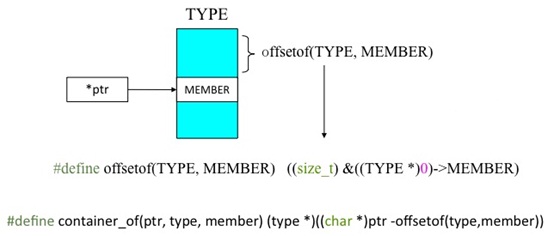
相关API
| API | 说明 |
|---|---|
| LIST_HEAD | 静态初始化list_head |
| INIT_LIST_HEAD | 动态初始化list_head |
| list_add | 在链表头部添加一个新节点 |
| list_add_tail | 在链表尾部添加一个新节点 |
| list_del | 删除一个节点 |
| list_del_init | 删除一个节点 |
| list_replace | 替换一个节点 |
| list_replace_init | 替换一个节点 |
| list_move | 将一个节点从一个链表中删除,并添加到另一个链表的头部 |
| list_move_tail | 将一个节点从一个链表中删除,并添加到另一个链表的尾部 |
| list_is_last | 判断节点是否为链表的最后一个节点 |
| list_empty | 判断链表是否为空 |
| list_empty_careful | 判断链表是否为空 |
| list_rotate_left | 将链表的第一个节点移动到末尾 |
| list_is_singular | 判断链表是否只有个节点 |
| list_cut_position | 将链表前面知道entry的部分删除,并添加到新的链表list中 |
| list_splice | 将两个链表链接在一起 |
| list_splice_tail | 将两个链表链接在一起 |
| list_splice_init | 将两个链表链接在一起 |
| list_splice_tail_init | 将两个链表链接在一起 |
| list_entry | 根据list_head找到其被嵌入的结构体 |
| list_first_entry | 获取链表的第一个entry |
| list_last_entry | 获取链表的最后一个entry |
| list_first_entry_or_null | 获取链表的第一个entry |
| list_next_entry | 获取链表指定entry的下一个entry |
| list_prev_entry | 获取链表指定entry的前一个entry |
| list_for_each | 遍历链表,遍历元素为list_head |
| list_for_each_safe | 遍历链表,遍历元素为list_head |
| list_for_each_prev | 反向遍历链表,遍历元素为list_head |
| list_for_each_prev_safe | 反向遍历链表,遍历元素为list_head |
| list_for_each_entry | 遍历链表,遍历元素为外层结构体 |
| list_for_each_entry_reverse | 反向遍历链表,遍历元素为外层结构体 |
| list_prepare_entry | 为list_for_each_entry_continue准备一个entry |
| list_for_each_entry_continue | 从当前节点的下一个节点进行遍历 |
| list_for_each_entry_continue_reverse | 从当前节点的下一个节点进行反向遍历 |
| list_for_each_entry_from | 从当前节点进行遍历 |
| list_for_each_entry_from_reverse | 从当前节点进行反向遍历 |
| list_for_each_entry_safe | 遍历链表,遍历元素为外层结构体 |
| list_for_each_entry_safe_reverse | 反向遍历链表,遍历元素为外层结构体 |
| list_for_each_entry_safe_continue | 从当前节点的下一个节点进行遍历 |
| list_for_each_entry_safe_from | 从当前节点进行遍历 |
| list_safe_reset_next | 用于在list_for_each_entry_safe中,跳过某个entry |
对上述API中的部分,我们进行了图示:
LIST_HEAD/INIT_LIST_HEAD
LIST_HEAD/INIT_LIST_HEAD两个宏用于初始化list_head节点。
|
|
图示如下:
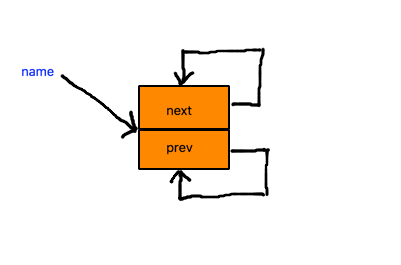
__list_add
include/linux/list.h(line 50)
|
|
图示如下:
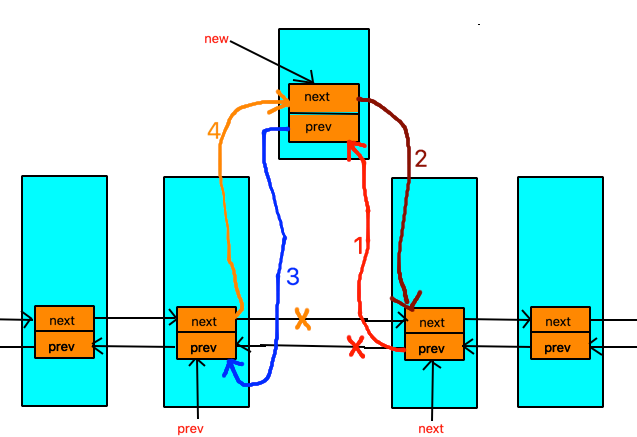
__list_del
include/linux/list.h(line 96)
|
|
图示如下:
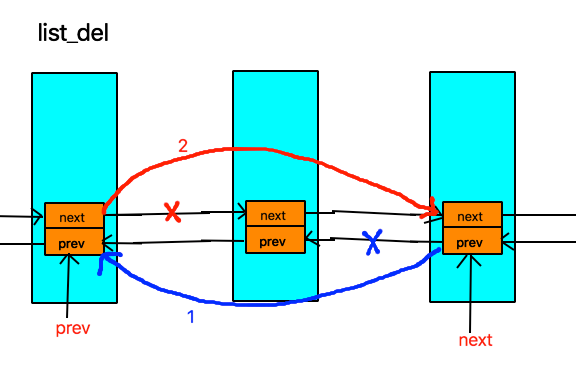
list_replace
include/linux/list.h(line 130)
|
|
图示如下:
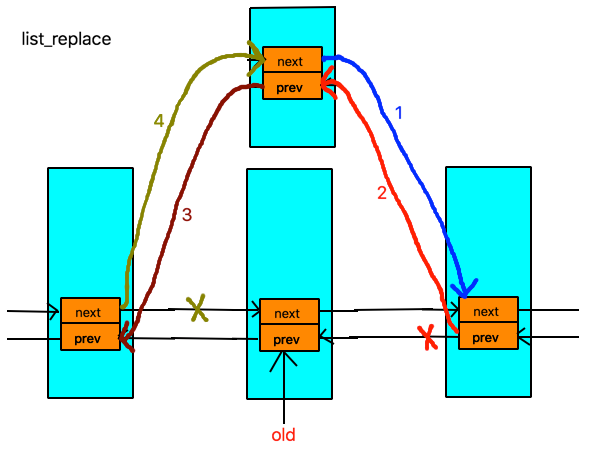
__list_cut_position
include/linux/list.h(line 248)
|
|
图示如下:
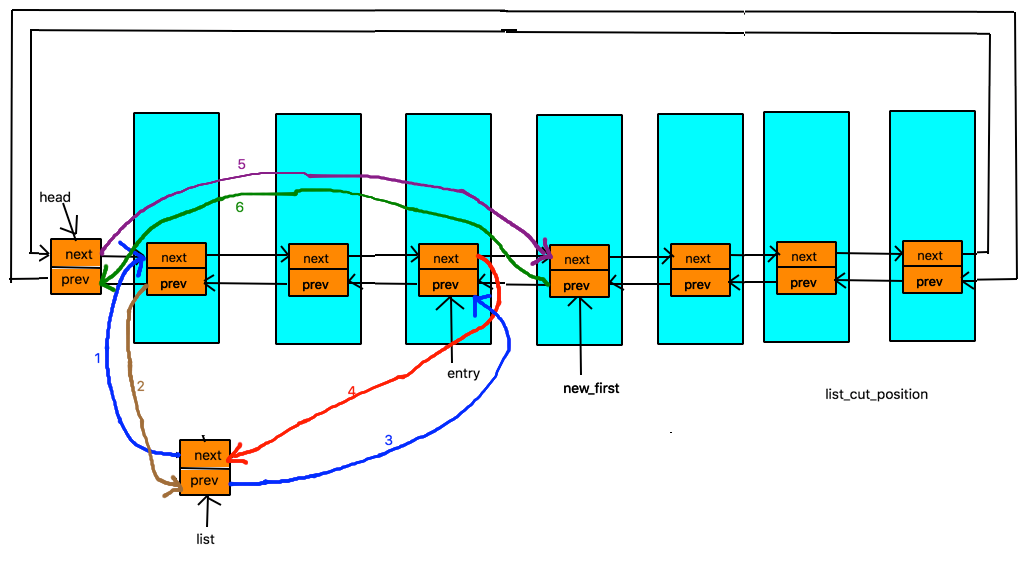
__list_splice
include/linux/list.h(line 288)
|
|
图示如下:
